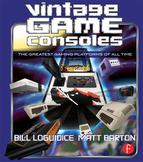History
As we saw in Chapter 1.3, Nolan Bushnell’s Atari company was almost single-handedly responsible for bringing videogames to the masses. Throughout the 1970s, Atari scored hit after hit in the arcades, and their Pong consoles—followed closely by the much more versatile VCS (or 2600)—had made them the undisputed king of the videogame industry. Unfortunately for Bushnell, his decision to sell his company to Warner Communications to fund development of the VCS ended in his departure soon after.
Bushnell, an engineer infused with an entrepreneur’s spirit, constantly butted heads with Ray Kassar, the no-nonsense businessman Warner had appointed president of Atari’s Consumer Division. Under Kassar’s direction, the creative and relaxed hacker culture of the company was transformed into an Office Space-like atmosphere1 of disgruntled nerds and humorless men in suits. According to Howard Scott Warshaw, the designer of Yar’s Revenge and ET, Kassar insisted on treating his game developers like blue-collar workers, refusing even to speak to anyone too low on the org chart. In Kassar’s mind, it took no more raw talent to make a game than it did to make towels or bars of soap. Whereas Bushnell’s Atari had been run by and for engineers, Kassar valued marketing experience, hiring managers from Polaroid and a tin can manufacturer. While Atari would have its greatest financial success in the years leading up to the Great Videogame Crash, this attitude would have obvious repercussions for the future of the company.
Shortly before Atari’s new computer line hit the shelves, Bushnell was forced out, turning his attention to his fledgling Chuck E. Cheese’s Pizza Time Theatre family restaurant company. Atari’s foray into home computers had been stymied by their strong relationship with Sears, who insisted on FCC Type 1 compliance. That meant strict limits on radio interference—a high standard that Apple and other home computer makers didn’t bother with. According to Bushnell, these regulations “turned out to have no teeth at all,” but time and money had been wasted trying to meet them.2
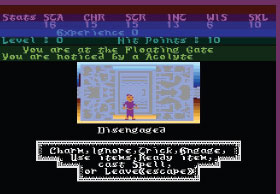
Alternate Reality: The City.
Alternate Reality: The City (1985, Datasoft, Inc.)
This unique first-person perspective role-playing game, designed by Philip Price, offered a number of innovative features such as an environment that responds to the player’s ethical decisions. The colorful graphics and effects are among the best on any 8-bit computer system. Feel free to sing along with the intro music; the lyrics are displayed karaoke-style! Also be sure to check out its 1987 sequel, Alternate Reality: The Dungeon.
With Bushnell gone, Warner promoted Kassar to CEO of the entire Atari Corporation. Kassar saw the future of Atari in home computers, and promptly launched and segregated a separate division to focus on their development.
Unlike their competition in the home computer market, which loudly touted their productivity and educational applications, Atari could also play to their strengths in the entertainment sector. Their “Candy” and “Colleen” 8-bit computer projects (it was an open secret that Atari engineers would code-name projects after attractive female employees) combined the proven game technology of the VCS and excellent computing capabilities with plug-and-play ease of use. Indeed, members of the VCS engineering team played a key role in its design, including industry legend Jay Miner, who had designed the innovative display hardware of Atari’s game console and led the development of what became the Commodore Amiga, which is discussed in Chapter 2.2.
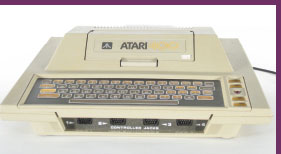
The Atari 400.
In late 1979, Atari released the Atari 400 (“Candy”) and the Atari 800 (“Colleen”). The 400 was intended as a starter computer, while the 800 was a higher-end alternative for more sophisticated users with deeper pockets. By 1980, Atari formed a large portion of Warner Communications’ total revenue and became the fastest growing company in US history, mirroring Apple’s own meteoric success and preceding Commodore’s ascension by several years. Their rapid gains in the home computer sector were due in part to their relatively low cost. For just a few hundred dollars more than an Atari VCS, you could afford a home computer without missing out on the games. As it was said in Electronic Games magazine in their 1983 Buyer’s Guide,
The Atari 400 is a microcomputer that was designed with game-players firmly in mind. Using a 6502 microprocessor combined with 128-color capability and four, independent sound synthesizers, gaming comes quite naturally to this budget-priced home computer.
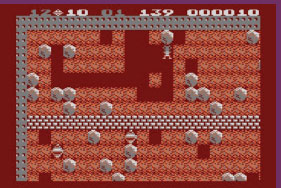
Boulder Dash.
Boulder Dash (1984, First Star Software, Inc.)
This classic third-person perspective puzzle-solving game was loosely based on an earlier 1982 arcade game by Taito called The Pit. Boulder Dash, developed by Peter Liepa and Chris Gray, brought the addictive concept to the home computer scene and is still ported to new platforms to this day. The player guides the spelunker Rockford through a series of caves, collecting treasures while avoiding monsters and falling boulders.
Unfortunately for Atari, there would soon be fierce competition from Texas Instruments and Commodore for the budget-minded home computer buyer.
Technical Specifications
The Atari 400, which used the MOS 6502B microprocessor, came with 8KB RAM (later 16KB), a cartridge port, four controller ports, television output, and a membrane keyboard. This keyboard, which featured slightly indented keys on its plastic sheet-like surface, was intended to be “childproof.” While it was easy to keep clean and was resistant to the occasional splash of Kool-Aid, it was painful to type on. With some technical effort, the memory could eventually be expanded to 48KB and the keyboard replaced. Even with those improvements in place, however, the 400 was a poor substitute for the 800. However, by 1982 it was possible to buy a new 400 for under $200, quite a reduction from its original sticker price of $549.95.3
The Atari 800 offered 16KB RAM (later 48KB), full-stroke keyboard, monitor output, expansion slots, and two cartridge ports (marked Left Cartridge and Right Cartridge). This dual-cartridge slot would remain unique to the system. The expansion slots were most often used for memory expansion, but also supported display adapters and other devices. Most expansion modules came in long plastic cases and snapped in like cartridges. Later releases were just boards without an enclosure, a utilitarian design that improved internal air flow. Most users outfitted the four slots with a 10KB ROM and three 16KB RAM modules to achieve the maximum standard 48KB system. The Atari 800 cost twice as much as a 400, originally retailing just shy of $1000. By 1983, the price had fallen to $400.
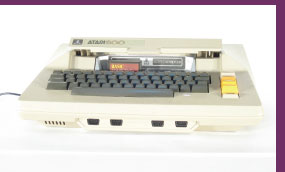
The Atari 800 with its cartridge door open and a BASIC cartridge inserted in the Left Cartridge slot.
With no cartridge inserted, both the 400 and 800 booted into a simple Notepad application. BASIC had to be loaded from cartridge, which was inserted into the Left Cartridge slot on the 800, allowing another cartridge to be used in the Right Cartridge slot, if needed. Because the Right Cartridge slot was rarely used, later Atari systems omitted this promising, but costly, feature.

Atari basic.
The Atari computers were pin compatible with VCS controllers, providing an excellent range of single-button digital control options. The four controller ports would not be repeated on another Atari system until the Atari 5200 SuperSystem in 1982, which was a videogame console based on the Atari 400, though it was not directly compatible.4

Bruce Lee.
Bruce Lee (1984, Datasoft, Inc.)
Designed by Ron J. Fortier, Bruce Lee is a combination of platformer and beat-’em-up gameplay. It features 20 challenging single-screen levels, tight controls, and puzzles to balance the intense arcade-style gameplay. In an innovative twist, a second player can control the Green Yamo, either helping or hindering Lee’s progress.
A small selection of games supported the additional controller ports. The most famous of these are Electronic Arts’ classic multiplayer strategy game by Dani Bunten, MULE (1983) and Atari’s own Super Breakout (1981), which accommodated up to an amazing eight players using four sets of paddle controllers. As with later versions of the Atari 5200, new entries in the 8-bit computer line would forego the extra pair of controller ports.
The sound of the Atari computers was generated by the versatile POKEY chip, which was a favorite for use in arcade machines, and would also influence the development of Atari’s later 7800 ProSystem console. The POKEY, which also read input from the keyboard and helped with serial communication, generated an impressive four channels (voices) of sound (the Commodore 64 had three). Thus, the Atari 8-bit computers offered the best potential audio performance for years. A simple internal speaker similar to the one in the Apple II emitted clicks when a key on the keyboard was pressed. This speaker was sometimes used as a fifth voice.
The original graphics chip, the CTIA, was an improved version of the VCS’s flexible TIA chip and was capable of an impressive range of color and resolution modes. In 1981, Atari upgraded the 400 and 800 with a new graphics chip, the GTIA, which was even more powerful. Both graphics chips worked with the ANTIC microprocessor to help balance the display workload for superior performance. This arrangement allowed for 12 different display mode combinations with the CTIA and 16 with the GTIA. All future Atari 8-bit systems would come standard with the GTIA.

Caverns of Mars.
Caverns of Mars (1981, Atari Program Exchange)
This fun and fast-paced variation on the 1981 arcade game Scramble lets you go where no rover has gone before: a heavily armed cavern of Mars! Programmed and designed by a high school student named Greg Christensen, Caverns of Mars became the best-selling APX title of all time and was made an official Atari release in 1983. We’re not quite sure how destroying fuel tanks refuels your ship, but you’ll be too busy dodging walls and missiles to ponder such things. If you like Caverns of Mars, be sure to check out the tweaked 1982 update Phobos, as well as the sequel, Caverns of Mars II, also from 1982.
As David Fox, former Lucasfilm Games Developer put it in an author interview,
When the Atari 400 and 800 came out, we were running the Marin Computer Center, the first public access microcomputer center. Most of our computers relied on a cassette player to load in games or programs (i.e., Apple II, TRS-80, Commodore PET, and our nine Processor Technology Sol 20s). Being able to load games via cartridges, and expand RAM with another cartridge, was a revolution in user friendliness to us. But then I learned about the special graphics and sound chip hidden in the Atari’s guts. I fell in love with its power (compared to everything else on the market) and decided to make it the focus of my Computer Animation Primer.5 Even just using the BASIC cartridge that came with these computers, it was easy to do some very cool tricks. And with a few assembly language helper routines, you could access smooth scrolling and player missile graphics. I was really sorry when the Commodore 64, which I considered to be an inferior computer, passed up the Atari’s in sales and popularity. Never could figure that out.
Peripherals such as printers, cassette recorders, and disk drives attached to the SIO port and could be daisy-chained. Although easy for the end-user and extremely versatile, this proprietary port required an adapter for use of third-party devices based on more typical industry standards.
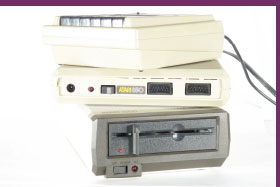
From top to bottom, the Atari 410 Program Recorder (tape drive), the Atari 850 Interface module (showing two SIO ports), and the Atari 1050 disk drive.
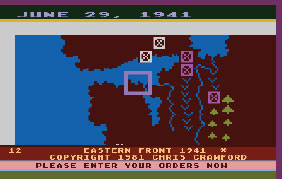
Eastern Front.
Eastern Front (1981, Atari Program Exchange)
Initially turned down by Atari because they thought a war game wouldn’t sell, Chris Crawford instead submitted his creation to the APX, where it became a great success. Eastern Front was noted for its accessible strategic gameplay and smooth scrolling. Perhaps its most innovative feature, however, was an AI that “thought” while the player was taking a turn, planning better moves the longer the player took. Like Caverns of Mars, Eastern Front was picked up by Atari for an official release in 1982, where Crawford took the time to make several improvements, including a move from disk to cartridge.
What follows are some of the highlights of the major Atari 8-bit systems released in the United States after the 400 and 800:
• 1982: With a consolidated number of chips, the Atari 1200XL, a sleek silver and black machine, was designed as a replacement for both the 400 and 800. When released, however, it was buggy, and the operating system sometimes rendered it incompatible with older software. The number of controller and cartridge ports was cut in half, and the internal speaker was removed, with the “fifth” channel of sound now routed in the same way as the POKEY’s audio. These changes would become standard in later models.
Interestingly, it’s been said that instead of replacing the aging 400 and 800 line, the Atari 1200XL actually increased sales of those systems when news of its issues spread. Whether actually true or not, the clumsy launch of the 1200XL did nothing to slow Commodore’s success with its low-priced VIC-20 and announcement of the powerful, and soon to be priced to move, Commodore 64.
• 1983: The Atari 600XL and 800XL were meant as replacements for the failed 1200XL. They had better backward compatibility and a tiered system approach similar to that of the 400/800. Both new systems had BASIC built in, and the 600XL shipped with 16KB RAM, while the 800XL featured 64KB. Despite the relative inconvenience, translator software addressed most of the remaining compatibility problems with older software. Unfortunately for Atari, by this time, the Commodore 64 was already establishing itself as the dominant 8-bit computer.
• 1985: The Atari 65XE/130XE replaced the black and silver XL line. These units were cheaper to manufacture and sell and had gray cases and keyboards that matched Atari’s new 16-bit ST line of systems. The 65XE came with 64KB RAM, while the 130XE contained an extra memory management unit, bringing its total to 128KB.
• 1987: After the Great Videogame Crash and Atari’s more aggressive return to the videogame market in 1986 with the reintroduction of the 7800 and the 2600 Jr., the company decided it was time to introduce a third console into the mix the following year. This unit was the XEGS (XE Game System). To fans, the XEGS could be seen as a complete, back-to-the-roots, reimagining of the 8-bit computer line based on the 65XE, with detachable keyboard, light gun, and built-in Missile Command. A skeptic might instead say it was an attempt by Atari to clear out old 8-bit computer software and accessories.
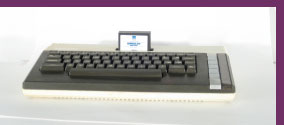
An Atari 800XL with Thorn Emi’s Jumbo Jet Pilot (1982) cartridge inserted.
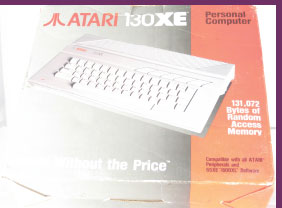
The box for the Atari 130XE.
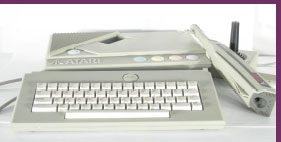
An Atari XEGS with matching joystick and light gun.
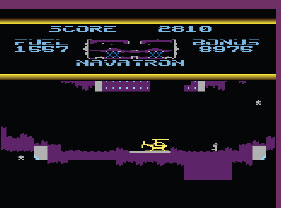
Fort Apocalypse.
Fort Apocalypse (1982, Synapse Software Corporation)
This fantastic helicopter-extraction game by Steve Hales has players coaxing a “Rocket Copter” into the heavily guarded bowels of a massive underground prison. Pay attention to your radar—the blips that follow you are probably enemy helicopters. You’ll also need precision bombing and piloting skills to blast through barricades and evade traps—oh, and there are people you should rescue, too. Heck, just refueling your chopper at the beginning of the game is a challenge!
Whatever the motives behind its creation and release, the XEGS represented a solid value at just $199.99, as it also came bundled with Flight Simulator II and Bug Hunt on separate cartridges. The latter supported the included light gun, while the former, which was previously an expensive disk game, represented the first of several such conversions to the more convenient form factor. Although the release of the XEGS brought an influx of re-released and new software for Atari 8-bit computers on cartridge (some not compatible with the older systems featuring less than 64KB), the three-console approach against the single Nintendo Entertainment System was ultimately ineffective.
The End of the Atari 8-Bit Line
So, with all the custom chips and comparatively impressive performance, what went wrong for Atari? The most likely answer is that the company couldn’t recover from the disappointment it caused with the highly anticipated 1200XL. Its efforts to atone for this mistake were too late and expensive to win back consumers, particularly when competitive price-cutting became downright cutthroat.
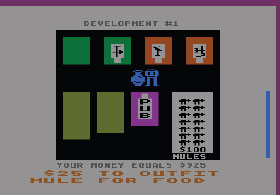
MULE.
MULE (1983, Electronic Arts)
Danielle Berry’s classic action strategy game pits up to four players in an intense race to settle a colony on Planet Irata (Atari spelled backward). MULE was part of EA’s early lineup and received the classic “rock album” style packaging that defined the publisher’s first years. A fan favorite despite so-so sales at the time, MULE is saturated with geeky insider-jokes and radiates with personality. Play against the AI, but it’s more fun with the family. If you have time left after assigning your MULEs to your plots, head to the mountains to hunt for the wampus. The instantly-recognizable theme music by Roy Glover is one of our favorite game tunes.
Unlike Apple, Atari was initially secretive about the inner workings of their systems. Often, no one would know something was even possible until Atari itself used the technique in a game or grudgingly divulged the information. This “trade secret” approach sometimes left a quality gap between first-party and third-party games. Nevertheless, clever programmers eventually found ways around Atari’s corporate policies to make impressive games of their own. Some critics point to On-Line Systems’ 1981 maze game Jawbreaker as a turning point for technically sound third-party titles on the platform, but it took another year before the system truly had a library of games that were a match for other 8-bit systems of the era. Certainly games from one Atari 8-bit maestro, Bill Williams, provides a clear example of this, as his Synapse-published games, Alley Cat (1982), an eclectic multiscreen action platformer, and Necromancer (1983), where you plant, defend, and control trees in a brilliant take-off on Robotron: 2084, were obvious stand-outs.
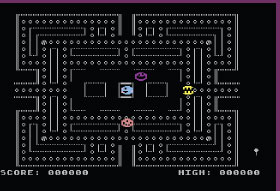
Jawbreaker.
Even though Atari was not very forthcoming about revealing technical information about the systems’ internals, the company nevertheless took a positive step towards fostering a strong user community with the creation of a new division, the Atari Program Exchange (APX). The APX featured a free quarterly mail order catalog of user-written software that went to all Atari computer owners who opted into the program. Users could both submit their own programs and purchase the programs of others, who would receive a small royalty from each sale, as well as occasional prize money.
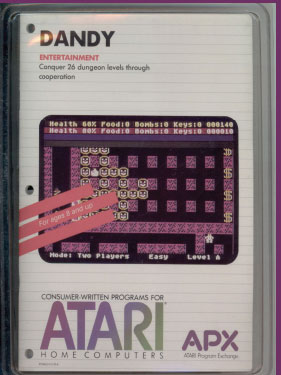
An APX package for the four player action dungeon-crawler, Dandy (1983), which was the inspiration for Atari’s arcade classic, Gauntlet (1985) and the later two-player only Dark Chambers (1988) for the Atari 8-bit, Atari 2600, and Atari 7800 platforms.
As a company known mostly for games, Atari never achieved the legitimacy of an Apple on the high end and was unable to sustain momentum or reduce prices in the low-end market, particularly after the Commodore 64 became dominant. In 1984, in the face of declining sales, Atari’s home computer and videogame divisions were bought from Warner Communications by former Commodore founder Jack Tramiel.
Tramiel formed Atari Corporation, and his leadership changed the course of both divisions after the Great Videogame Crash of 1984. He steered the company away from its focus on the videogame market and turned to the development of a new 16-bit line of computers. Atari staked its future on its 16-bit Atari ST systems, which launched in 1985.
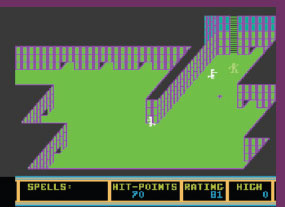
Mike Edwards’ Realm of Impossibility.
Mike Edwards’ Realm of Impossibility (1983, Electronic Arts, Inc.)
An improved version of Mike Edwards’ earlier self-published Zombies, this isometric puzzle-solving action maze game puts players through 13 M.C. Escher-inspired dungeon levels in a quest to defeat an evil cleric. Be sure to try out the acclaimed two-player mode, which allows for coordinated strategies that really lets the game design shine.
However, the company began to place greater focus on videogames again in 1986, leaving even fewer resources for properly supporting the 8-bit computers. Still, even as “third choice” systems for a good portion of their initial run, the Atari 8-bit computers were a success, especially considering the early exits of many competitors. Atari Corporation dropped its support for the 8-bit computer line on January 1, 1992, formally ending an eventful 12-year odyssey. Unofficially, of course, the creative energy around the platform wouldn’t be quite so easy to extinguish.
The Atari 8-Bit Community Then and Now
Like most of the early computer game communities, fans of the Atari 8-bit were usually interested in playing games and learning how to program. They were also ferociously defensive of their chosen brand, despising the growing legions of Commodore fans.
As “Magic Knight” commented on the AtariAge forums,
I’m glad my dad picked up an Atari 800XL instead of a Commodore 64. It opened my eye to all aspects of computers and how they worked—if I’d had a C64 I would have just played games instead of exploring behind the scenes, as the magazines for the C64 didn’t give enough balance to programming and hardware like the Atari’s.
Today, Atari 8-bit fans can easily find like-minded people on online forums such as AtariAge, which boasts a very active and supportive base of dedicated users. Another good resource is Bostjan Gorisek’s Atari 8-Bit Forever site (http://gury.atari8.info), which contains a massive amount of information on games, hardware, books, and more.
As Mike Vox commented on the Armchair Arcade website,
The original Atari 800 is unique in the history of home computers. It has four built-in joystick ports, all easily accessible from the front of the unit (early games like MULE and Survivor took advantage of the four joystick ports). It has two heavy-duty cartridge slots. The top hatch also flips open to easily plug in expandable memory cards. The Atari 800 was built like a tank with a very robust keyboard. Unfortunately, these unique features are missing on all later models where the design was streamlined.
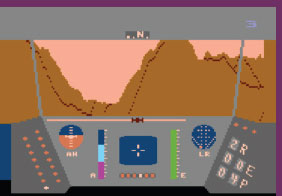
Rescue on Fractalus!
Rescue on Fractalus! (1984, Lucasfilm Games LLC)
Loosely inspired by Star Wars, this 3D flight simulation game puts players in the cockpit of a search-and-rescue aircraft. The innovative fractal-based routines for generating randomized terrain, created by Loren Carpenter, give it its title and tremendous replay-value. What most gamers remember, though, is that guy with the green helmet… For other titles from Lucasfilm Games that leveraged the same innovative fractal-based technology, be sure to check out first-person shooter and adventure game The Eidolon and action strategy game Koronis Rift, both from 1985.
Since the end of its commercial lifecycle, new homebrew games have been regularly released both commercially on cartridge, tape, and disk, as well as for free as images to play on your favorite emulator or to transfer for use on a real Atari computer. In recent years, there have been on average as many as a dozen quality new releases annually. Some highlights include arcade conversion Bomb Jack (2008), which requires a full 320KB of RAM, platformer Mighty Jill Off (2011), and action puzzler Ridiculous Reality (2012). These and a large database of other games, both new and old, are cataloged and usually available for download from the excellent Atarimania website.
Collecting Atari 8-Bit Systems
Obviously, new Atari 8-bit collectors have many things to consider when making their first system purchase. There are several different models and configurations available, as Electronic Games magazine editorialized as early as December 1983:
The overnight switch from the 400 and 800 to the XL series may confuse some potential buyers. It isn’t always easy to figure out which machines have which features—and Atari’s dismal naming system doesn’t exactly endow each model with a distinctive personality.
Optimally, a hardcore collector would have both a 48KB 800 with GTIA and a minimum 64KB XL or XE system, for the full spectrum of native compatibility. If you’re just going to get one, however, go for an XL or XE. Today, most of the various Atari 8-bit computer variations are available for around the same price, with the final choice often coming down to a buyer’s preference for a particular system style and class.
The XEGS came with both a light gun and a classic Atari-style joystick with gray styling instead of the usual all black. The joystick functioned as expected, but the light gun was generally inaccurate in comparison to the equivalent on the Nintendo Entertainment System or Sega Master System.
The classic 48KB 800 had four controller ports and a second cartridge slot—features that no other Atari 8-bit could match. Although not without its quirks, Atari’s 1200XL is generally considered to have the best keyboard and styling of any model in the line. The 64KB XEGS is the only Atari 8-bit with a detachable keyboard and functions like a videogame console without one. The 130XE is the only Atari 8-bit with 128KB of standard memory, though most of the other models are expandable well beyond that amount.
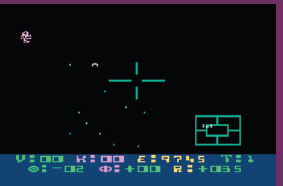
Star Raiders.
Star Raiders (1979, Atari, Inc.)
Doug Neubauer’s Star Raiders6 is a massively influential dogfighting game set in space. Its fully-navigable 3D environment all the more impressive when one considers it required only 8K of RAM and 8K of ROM. Modern developers use more resources than that for a single letter! Despite the game’s popularity and technical innovations, Atari’s miserly policies prevented Neubauer from collecting royalties on his masterpiece. Perhaps that’s why the Zylons got so riled up against the Atarian Federation.
Software on cartridges, cassettes, and disks are also easy to locate, with a range of online stores and auction websites still catering to the platform. Since Atari 8-bit computers used the same controller connection standard as the VCS, any compatible joystick, paddle, or other controller will work fine. Many Sega Master System and Sega Genesis gamepads are also compatible.
The XG-1 light gun that came with the XEGS (also available separately) is unique to the Atari 8-bit line. It’s the only light gun Atari ever released and is used by a small number of games on both the VCS and Atari 7800. Collectors of those systems are often on the lookout for one as well.
Peripherals are nearly as plentiful as the systems themselves, with a good range of compatible cassette recorders, disk drives, and printers still available at reasonable prices. If you don’t wish to deal with the quirks of classic tape drives, disk drives, or even cartridges, though, there are many modern options available to make using the classic Atari 8-bit computers far more enjoyable. Atarimax offers several great options, including the Maxflash USB Cartridge System, which lets you store multiple programs on a cartridge for quick access from your Atari computer, and the Universal SIO2PC/ProSystem interface, which works with APE for Windows to allow bi-directional control of both PC and Atari peripherals for the ultimate in flexibility. Lotharek.pl offers a product called Sio2sd, which lets you easily load programs into your Atari computer via its SIO interface directly from an SD or MMC flash card.
Emulating the Atari 8-bit
There are several unauthorized emulators available for the Atari 8-bit. Perhaps the most popular is Atari800Win PLus, a free and versatile emulator for Microsoft Windows. Other popular options include Atari800MacX for Macintosh computers, and Atari++, which works on Linux, Unix, and Windows systems, and offers cycle-precise emulation. If you own an Android smart-phone or tablet, one of the better options is Colleen.
Emulation is often hampered by the need for system ROM BIOS images, which are still under copyright and thus illegal to host. While it is possible to extract the ROM information from an actual Atari 8-bit computer, this procedure is likely too complex and involved for a casual user. Despite the threat of litigation, however, there are several websites that make the system ROMs available for use in any emulator. Google is your friend.
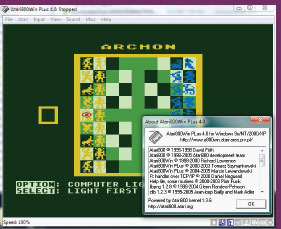
Atari800Win Plus 4.0 running the action strategy classic Archon: The Light and the Dark (1983, Electronic Arts).
1 The cult favorite 1999 film from Mike Judge satirizing work life at an American software company in the 1990s.
2 See Benj Edwards’ “VC&G Interview: Nolan Bushnell, Founder of Atari,” www.vintagecomputing.com/index.php/archives/404.
3 See the Atari 400 entry at http://oldcomputers.net.
4 Thanks to clever hacks, fans of the Atari 5200 have seen many conversions of classic Atari 8-bit games over the years.
6 For an in-depth look at the game, see “The History of Star Raiders: Taking Command” on Gamasutra, www.gamasutra.com/view/feature/132516/the-history-of-star-raiders-.php?page=1.
